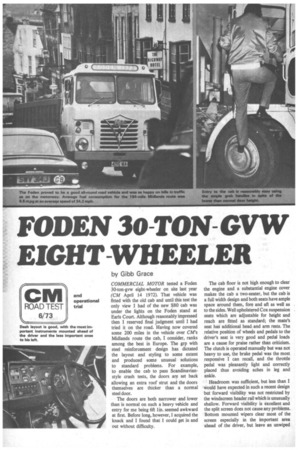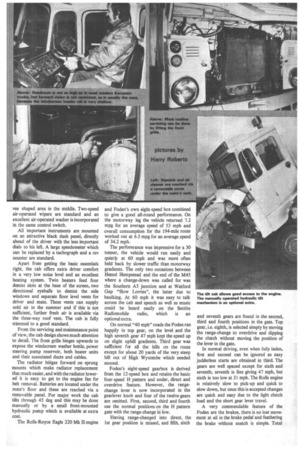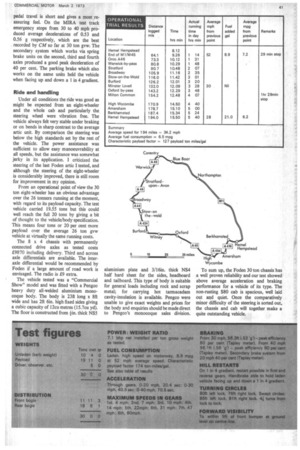FODEN 30-TONGVW EIGHT-WHEELER
Page 40

Page 41

Page 43

If you've noticed an error in this article please click here to report it so we can fix it.
by Gibb Grace COMMERCIAL MOTOR tested a Foden 30-ton-gvw eight-wheeler on site last year (CM April 14 1972). That vehicle was fitted with the old cab and until this test the only view I had of the new S80 cab was under the lights on the Foden stand at Earls Court. Although reasonably impressed then I reserved final judgment until I had tried it on the road. Having now covered some 200 miles in the vehicle over Ors Midlands route the cab, I consider, ranks among the best in Europe. The grp with steel reinforcement design has dictated the layout and styling to some extent and produced some unusual solutions to standard problems. For example, to enable the cab to pass Scandinavianstyle crash tests, the doors are set back allowing an extra roof strut and the doors themselves are thicker than a normal steel door.
The doors are both narrower and lower than is normal on such a heavy vehicle and entry for me being 6ft lin. seemed awkward at first. Before long, however, I acquired the knack and I found that I could get in and out without difficulty.
The cab floor is not high enough to clear the engine and a substantial engine cover makes the cab a two-seater, but the cab is a full width design and both seats have ample space around them, fore and aft as well as to the sides. Well upholstered Cox suspension seats which are adjustable for height and reach are fitted as standard; the mate's seat has additional head and arm rests. The .relative position of wheels and pedals to the driver's seat is very good and pedal loads are a cause for praise rather than criticism. The clutch is operated manually but was not heavy to use, the brake pedal was the most responsive I can recall, and the throttle pedal was pleasantly light and correctly placed thus avoiding aches in leg and ankle.
Headroom was sufficient, but less than I would have expected in such a recent design but forward visibility was not restricted by the windscreen header rail which is unusually shallow. Forward visibility is excellent and the split screen does not cause any problems. Bottom mounted wipers clear most of the screen especially in the important area ahead of the driver, but leave an unwiped vee shaped area in the middle. Two-speed air-operated wipers are standard and an excellent air-operated washer is incorporated in the same control switch.
All important instruments are mounted on an attractive black dash panel, directly ahead of the driver with the less important dials to his left. A large speedometer which can be replaced by a tachograph and a rev counter are standard.
Apart from getting the basic essentials right, the cab offers extra driver comfort in a very low noise level and an excellent heating system. Twin heaters feed four demist slots at the base of the screen, two directional eyeballs to demist the side windows and separate floor level vents for driver and mate. These vents can supply cold air in the summer and if this is not sufficient, further fresh air is available via the three-way roof vent. The cab is fully trimmed to a good standard.
From the servicing and maintenance point of view, the cab design shows much attention to detail. The front grille hinges upwards to expose the windscreen washer bottle, power steering pump reservoir, both heater units and their associated ducts and cables.
The radiator hifiges forward on sprung mounts which make radiator replacement that much easier, and with the radiator lowered it is easy to get to the engine fan for belt removal. Batteries are located under the mate's floor and these are reached via a removable panel. For major work the cab tilts through 45 deg and this may be done manually or by a small front-mounted hydraulic pump which is available at extra cost.
The Rolls-Royce Eagle 220 Mk II engine and Foden's own eight-speed box combined to give a good all-round performance. On the motorway leg the vehicle returned 7.2 mpg for an average speed of 53 mph and overall consumption for the 194-mile route worked out at 6.5 mpg for an average speed of 34.2 mph.
The performance was impressive for a 30 tonner, the vehicle would run easily and quietly at 60 mph and was more often held back by slower traffic than motorway gradients. The only two occasions between Hemel Hempstead and the end of the M45 where a change-down was called for was the Southern AS junction and at Watford Gap "Slow Lorries", the latter due to baulking. At 60 mph it was easy to talk across the cab and speech as well as music could be heard easily on the Smiths Radiomobile radio, which is an optional extra.
On normal "40 mph" roads the Foden ran happily in top gear, on the level and the high seventh gear 47 mph kept the speed up on slight uphill gradients. Third gear was sufficient fix all the hills on the route except for about 20 yards of the very steep hill out of High Wycombe which needed second.
Foden's eight-speed gearbox is derived from the 12-speed box and retains the basic four-speed H pattern and under, direct and overdrive feature. However, the rangechange lever is now incorporated in the gearlever knob and four of the twelve gears are omitted. First, second, third and fourth use the normal positions on the H pattern gate with the range-change in low.
Having range-changed into direct, the 1st gear position is missed, and fifth, sixth and seventh gears are found in the second, third and fourth positions in the gate. Top gear, i.e. eighth, is selected simply by moving the range-change to overdrive and dipping the clutch without moving the position of the lever in the gate.
In normal driving, even when fully laden, first and second can be ignored as easy judderless starts are obtained in third. The gears are well spaced except for sixth and seventh; seventh is fine giving 47 mph, but sixth is too low at 31 mph. The Rolls engine is relatively slow to pick-up and quick to slow down, but once this is accepted changes are quick and easy due to the light clutch load and the short gear lever travel.
A very commendable feature of the Foden are the brakes, there is no lost movement at all in the brake pedal and feathering the brake without snatch is simple. Total
pedal travel is short and gives a most,reassuring feel. On the MIRA test track emergency stops from 30 to 40 mph produced average decelerations of 0.53 and 0.56 g respectively, which are the best recorded by CM so far at 30 ton gvw. The secondary system which works via spring brake units on the second, third and fourth axles produced a good peak deceleration of 40 per cent. The parking brake which also works on the same units held the vehicle when facing up and down a 1 in 4 gradient.
Ride and handling
Under all conditions the ride was good as might be expected from an eight-wheeler and the whole cab and particularly the steering wheel were vibration free. The vehicle always felt very stable under braking or on bends in sharp contrast to the average artic unit. By comparison the steering was below the high standards set by the rest of the vehicle. The power assistance was sufficient to allow easy manoeuvrability at all speeds, but the assistance was somewhat jerky in its application. I criticized the steering of the last Foden artic I tested, and although the steering of the eight-wheeler is considerably improved, there is still room for improvement in my opinion.
From an operational point of view the 30 ton eight-wheeler has an obvious advantage over the 26 tonners running at the moment, with regard to its payload capacity. The test vehicle carried 19.55 tons but this could well reach the full 20 tons by giving a bit of thought to the vehicle/body specification.
• This means four tons or 20 per cent more payload over the average 26 ton gvw vehicle at virtually the same running costs. The 8 x 4 chassis with permanently connected drive axles as tested costs £9870 including delivery. Third and across axle differentials are available. The interaxle differential would be recommended by Foden if a large amount of road work is envisaged. The radio is £9 extra.
• The vehicle tested was a "Commercial Show" model and was fitted with a Pengco heavy duty all-welded aluminium monocoque body. The body is 23ft long x 8ft wide and has 2ft 6in. high fixed sides giving a cubic capacity of 12cu metres (15.7cu yd), The floor is constructed from +in. thick NS5 aluminium plate and 3/16in. thick NS4 half hard sheet for the sides, headboard and tailboard. This type of body is suitable for general loads including rock and scrap metal; for carrying hot tannacadam cavity-insulation is available. Pengco were unable to give exact weights and prices for the body and enquiries should be made direct to Pengco's monocoque sales division. To sum up, the Foden 30 ton chassis has a well proven reliability and our test showed above average acceleration and braking performance for a vehicle of its type. The non-rusting S80 cab is spacious, well laid out and quiet. Once the comparatively minor difficulty of the steering is sorted out, the chassis and cab will together make a quite outstanding vehicle.




































































































